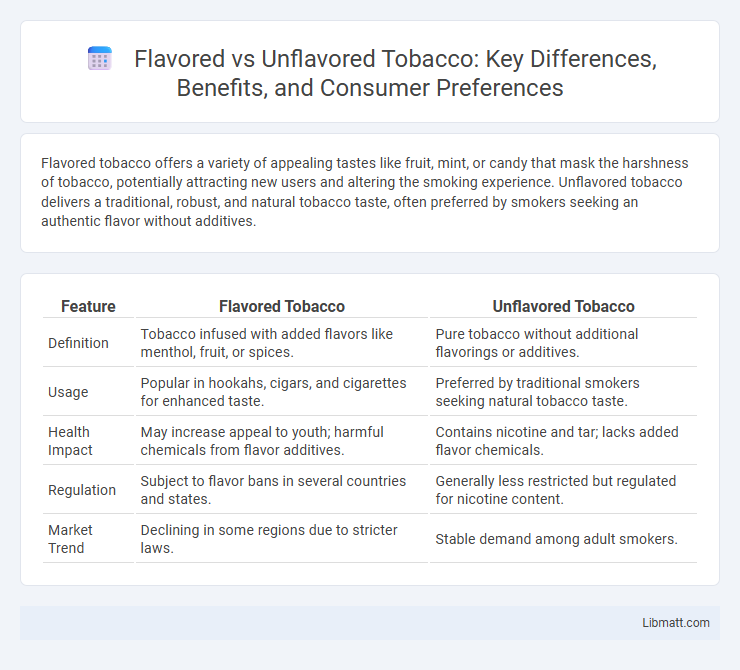Flavored tobacco offers a variety of appealing tastes like fruit, mint, or candy that mask the harshness of tobacco, potentially attracting new users and altering the smoking experience. Unflavored tobacco delivers a traditional, robust, and natural tobacco taste, often preferred by smokers seeking an authentic flavor without additives.
Table of Comparison
| Feature | Flavored Tobacco | Unflavored Tobacco |
|---|---|---|
| Definition | Tobacco infused with added flavors like menthol, fruit, or spices. | Pure tobacco without additional flavorings or additives. |
| Usage | Popular in hookahs, cigars, and cigarettes for enhanced taste. | Preferred by traditional smokers seeking natural tobacco taste. |
| Health Impact | May increase appeal to youth; harmful chemicals from flavor additives. | Contains nicotine and tar; lacks added flavor chemicals. |
| Regulation | Subject to flavor bans in several countries and states. | Generally less restricted but regulated for nicotine content. |
| Market Trend | Declining in some regions due to stricter laws. | Stable demand among adult smokers. |
Introduction to Flavored and Unflavored Tobacco
Flavored tobacco contains added ingredients such as menthol, fruit, or candy flavors that enhance taste and aroma, appealing especially to younger or novice smokers. Unflavored tobacco maintains its natural, robust tobacco profile without additives, often preferred by traditional or experienced users who favor authenticity. Regulatory measures targeting flavored tobacco aim to reduce its appeal due to associations with increased addiction risk and youth initiation.
History and Evolution of Tobacco Flavors
Tobacco flavors have evolved significantly since their introduction in the 17th century, when flavored tobacco was first used to mask the harshness of natural tobacco. Flavored tobacco gained popularity in the 20th century with products like menthol cigarettes, which offered a smoother smoking experience and attracted diverse consumer groups. Today, understanding the history and evolution of tobacco flavors helps you recognize how flavorings impact user preferences and regulatory policies worldwide.
Key Differences Between Flavored and Unflavored Tobacco
Flavored tobacco contains additives like fruit, mint, or spice flavors that enhance the sensory experience and mask the natural taste of tobacco, while unflavored tobacco retains its pure tobacco leaf flavor with no added taste enhancements. Flavored tobacco often appeals to younger users and can influence smoking initiation, whereas unflavored tobacco is typically preferred by traditional smokers seeking a stronger, more authentic tobacco taste. Understanding these differences helps you choose tobacco products based on flavor preference, usage habits, and health considerations.
Popular Flavored Tobacco Varieties
Popular flavored tobacco varieties include fruit flavors like cherry, apple, and grape, as well as menthol, vanilla, and cinnamon, offering a sweeter and more aromatic smoking experience compared to traditional unflavored tobacco. These flavors are especially favored in products such as hookah, cigars, and certain cigarette brands, catering to consumers seeking a diverse taste profile. Your choice between flavored and unflavored tobacco depends on whether you prefer a classic tobacco taste or a more vibrant, flavored smoking option.
Health Impacts: Flavored vs Unflavored Tobacco
Flavored tobacco products often contain additives that enhance taste but can increase the risk of respiratory irritation and toxicity compared to unflavored tobacco. Studies indicate that flavored tobacco, such as menthol or fruit-flavored variants, can facilitate deeper inhalation and higher nicotine absorption, exacerbating addiction and cardiovascular risks. Unflavored tobacco generally presents a more straightforward chemical profile but retains significant health dangers, including carcinogen exposure and chronic lung disease.
Youth Appeal and Consumption Trends
Flavored tobacco products, including fruit, candy, and menthol varieties, have significantly increased youth appeal due to their sweet and enticing taste, masking the harshness of tobacco and encouraging experimentation among young users. Data from the Centers for Disease Control and Prevention (CDC) indicate that nearly 80% of youth tobacco consumers prefer flavored options, contributing to higher initiation rates and sustained use compared to unflavored tobacco. Understanding these consumption trends can help you recognize the critical role flavored tobacco plays in youth tobacco epidemics and inform prevention strategies targeting adolescent populations.
Legal Regulations on Flavored Tobacco
Legal regulations on flavored tobacco vary significantly across countries, with many jurisdictions implementing bans or restrictions to curb youth appeal and reduce health risks. The U.S. Food and Drug Administration (FDA) enforces strict rules prohibiting flavored cartridge-based e-cigarettes, excluding menthol and tobacco flavors, under the Family Smoking Prevention and Tobacco Control Act. European Union policies under the Tobacco Products Directive mandate flavor bans in cigarettes and roll-your-own tobacco to prevent initiation among young smokers, reflecting a global trend toward tighter control on flavored tobacco products.
Consumer Preferences and Market Demand
Consumer preferences for flavored tobacco products have surged due to their appealing varieties such as menthol, fruit, and spice, which attract younger demographics and initiate first-time smokers. Unflavored tobacco maintains a steady demand among traditional smokers who prefer the natural, robust tobacco taste without additives. Market demand analysis reveals that flavored tobacco commands a significant share of the growth segment, while regulatory pressures in various regions influence shifts in consumer behavior and sales trends.
The Role of Flavors in Smoking Cessation
Flavored tobacco products often mask the harshness of nicotine, potentially discouraging smoking cessation by enhancing sensory appeal and increasing addiction risk. Unflavored tobacco lacks these additives, which may reduce reinforcement and support efforts to quit nicotine use more effectively. Research indicates that eliminating flavors from tobacco products can decrease initiation rates and aid smokers in overcoming dependence.
Future Outlook: The Fate of Flavored and Unflavored Tobacco
The future outlook for flavored and unflavored tobacco is shaped by evolving regulatory landscapes and shifting consumer preferences favoring reduced-risk products. Stricter flavor bans aim to curb youth initiation of flavored tobacco, potentially diminishing its market share, while unflavored tobacco faces declining popularity but remains under regulatory scrutiny. Innovation in harm reduction and alternative nicotine delivery systems is poised to redefine the tobacco market trajectory, impacting the demand and regulatory treatment of both flavored and unflavored tobacco products.
Flavored vs unflavored tobacco Infographic

 libmatt.com
libmatt.com